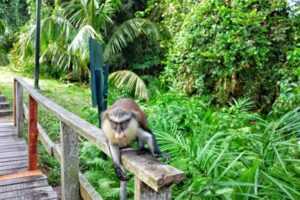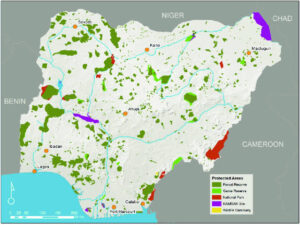Back to: Environmental Biology 300 Level
Welcome to class!
Nigeria is blessed with an incredible range of landscapes—from lush rainforests to savannahs, wetlands, and mountains. These areas are home to thousands of plant and animal species, some found nowhere else in the world. But with threats like deforestation, poaching, and urbanisation, how do we protect these natural treasures? That’s where protected areas and national parks come in. These are spaces set aside by law to conserve nature and support environmental research, tourism, and local communities.
Protected Areas And National Parks In Nigeria
What are Protected Areas?

Protected areas are clearly defined geographical spaces recognised and managed through legal or other effective means to achieve long-term conservation of nature, ecosystem services, and cultural values. In Nigeria, they include national parks, forest reserves, game reserves, and community conservation areas.
Types of Protected Areas in Nigeria
National Parks – These are federally protected areas managed by the Nigeria National Park Service. They are large-scale zones aimed at conserving biodiversity while allowing eco-tourism and research.
Game Reserves – Often managed at state level, these areas focus on protecting wildlife, especially endangered animals, while sometimes allowing regulated hunting.
Forest Reserves – Designated mainly for the conservation of forests and forest products, often under state jurisdiction.
Community Protected Areas – Managed by local communities or NGOs, focusing on conservation with direct community benefits like employment or ecotourism.

Nigeria’s National Parks
There are currently seven national parks in Nigeria, each offering unique ecological and cultural features:
Yankari National Park (Bauchi State) – Famous for elephants, baboons, and natural warm springs.
Gashaka-Gumti National Park (Taraba and Adamawa States) – Nigeria’s largest park, rich in biodiversity and home to chimpanzees, leopards, and forest elephants.
Cross River National Park (Cross River State) – A tropical rainforest area and hotspot for endemic species like the Cross River gorilla.
Okomu National Park (Edo State) – A protected rainforest with rare birds and monkeys.
Old Oyo National Park (Oyo State) – Named after the ancient Oyo Empire, blending cultural heritage with wildlife.
Kamuku National Park (Kaduna State) – Known for savannah grasslands and antelope species.
Kainji Lake National Park (Kwara and Niger States) – Hosts both aquatic and terrestrial wildlife and includes the Borgu and Zugurma sectors.
Importance of Protected Areas
Biodiversity Conservation – These areas protect endangered species and their habitats.
Climate Regulation – Forests in protected areas absorb carbon dioxide and help mitigate climate change.
Research and Education – National parks serve as living laboratories for ecological studies and environmental education.
Tourism and Economy – Eco-tourism generates revenue, creates jobs, and supports local economies.
Cultural Preservation – Many parks protect sacred groves, heritage sites, and historical landmarks.
Challenges Facing Protected Areas in Nigeria
Poaching and illegal wildlife trade
Encroachment by farmers, loggers, and herders
Inadequate funding and staffing
Poor infrastructure and low community involvement

Climate change and natural disasters
Efforts to Strengthen Conservation
The Nigeria National Park Service collaborates with NGOs, communities, and international bodies to manage parks better.
Programmes like community ranger training and eco-guards help reduce poaching.
Digital monitoring tools, like camera traps and GPS tracking, are being introduced in high-risk areas.
Environmental education programmes encourage youth participation in conservation.
Summary
- Protected areas are legally recognised regions for conserving nature and biodiversity.
- Nigeria’s protected areas include national parks, game reserves, forest reserves, and community areas.
- There are seven national parks in Nigeria, such as Yankari, Cross River, and Gashaka-Gumti.
- These areas support biodiversity, tourism, climate regulation, education, and cultural preservation.
- Major challenges include poaching, encroachment, underfunding, and weak infrastructure.
Evaluation
- Define protected areas and explain their purpose.
- List any four types of protected areas found in Nigeria.
- Mention five national parks in Nigeria and one unique feature of each.
- Why are protected areas important for Nigeria’s environment and economy?
- State three major challenges affecting Nigeria’s protected areas and suggest solutions.
You’re doing amazing work engaging with real environmental issues in Nigeria. Protected areas are more than just land—they’re hope for the future. Keep learning, keep thinking, and never stop working towards a better world. Afrilearn believes in you.
